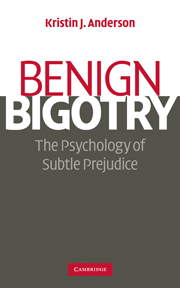Book contents
- Frontmatter
- Contents
- Acknowledgments
- Introduction: The changing place of prejudice: a migration underground
- 1 “Those people all look alike”: The myth of the other
- 2 “They must be guilty of something”: Myths of criminalization
- 3 “Feminists are man-haters”: Backlash myth-making
- 4 “Gays flaunt their sexuality”: The myth of hypersexuality
- 5 “I'm not a racist, I'm colorblind”: The myth of neutrality
- 6 “Affirmative action is reverse racism”: The myth of merit
- Conclusion
- Index
5 - “I'm not a racist, I'm colorblind”: The myth of neutrality
Published online by Cambridge University Press: 05 June 2012
- Frontmatter
- Contents
- Acknowledgments
- Introduction: The changing place of prejudice: a migration underground
- 1 “Those people all look alike”: The myth of the other
- 2 “They must be guilty of something”: Myths of criminalization
- 3 “Feminists are man-haters”: Backlash myth-making
- 4 “Gays flaunt their sexuality”: The myth of hypersexuality
- 5 “I'm not a racist, I'm colorblind”: The myth of neutrality
- 6 “Affirmative action is reverse racism”: The myth of merit
- Conclusion
- Index
Summary
Now, I don't see color. People tell me I'm white and I believe them because police officers call me “sir.”
Stephen Colbert, host of The Colbert ReportThe notion of colorblindness has been idealized popularly since the late 1960s as a frame of mind that could combat racism. Perhaps the most well-known reference to a colorblind ideal is from Dr. Martin Luther King, Jr.,'s famous “I have a dream” speech in which he imagined an America where his children would be judged “not by the color of their skin but by the content of their character.” But what is entailed in colorblind beliefs and in the policies and practices that would accompany such a position? Is colorblindness good for people of color? Is it good for society overall? And what about racial colorblindness at the individual level, in terms of people's attitudes about race and ethnicity? In a multiracial, multiethnic society such as the US, what does it mean for a person to desire not to see race? Is it possible for people to be colorblind, to ignore someone's race or ethnicity in their interactions, to judge people only by the content of their character? If color matters in society, as part of one's self-concept, in social identity, in social policy, and in everyday life, what does it mean to not see it?
- Type
- Chapter
- Information
- Benign BigotryThe Psychology of Subtle Prejudice, pp. 239 - 277Publisher: Cambridge University PressPrint publication year: 2009



